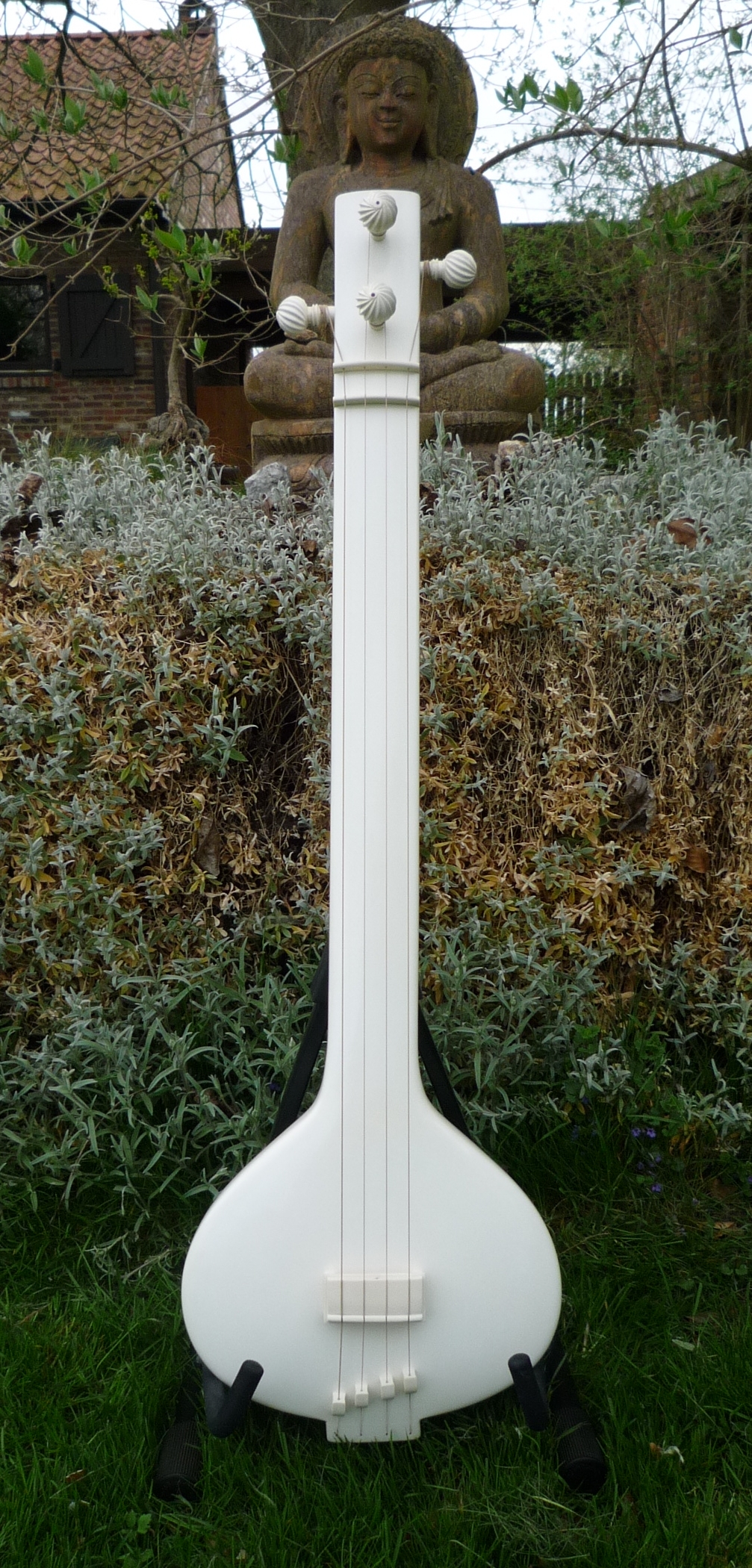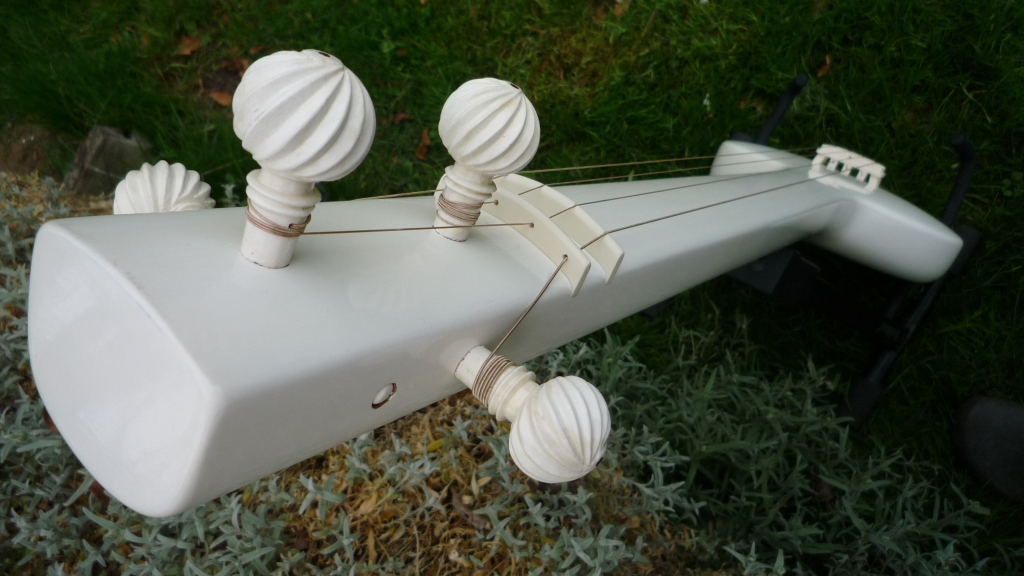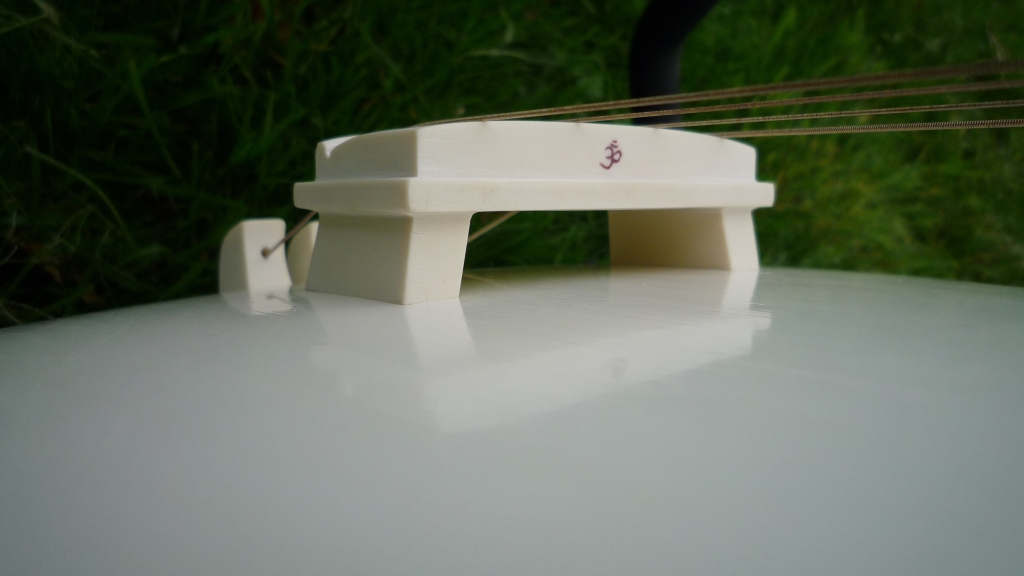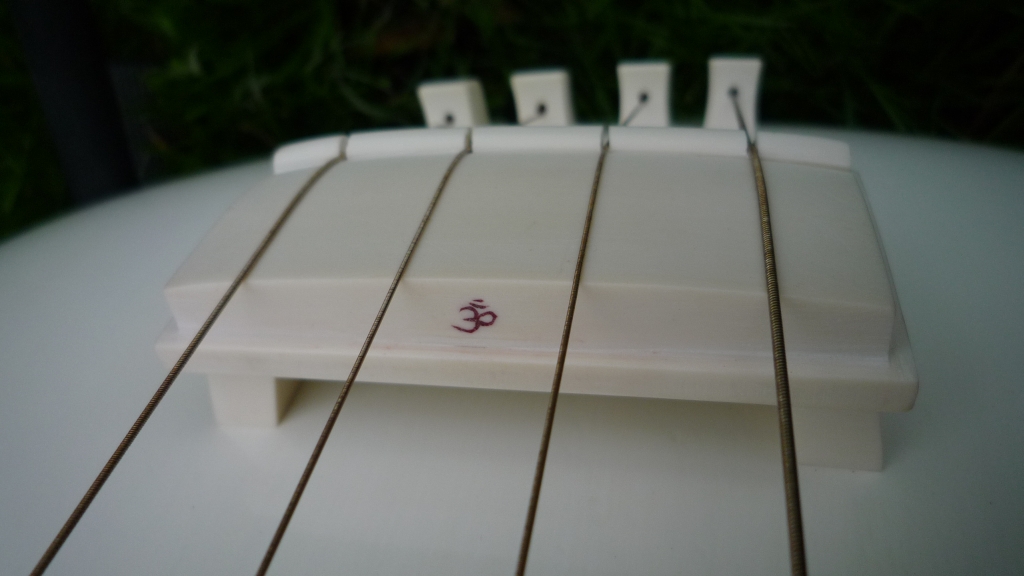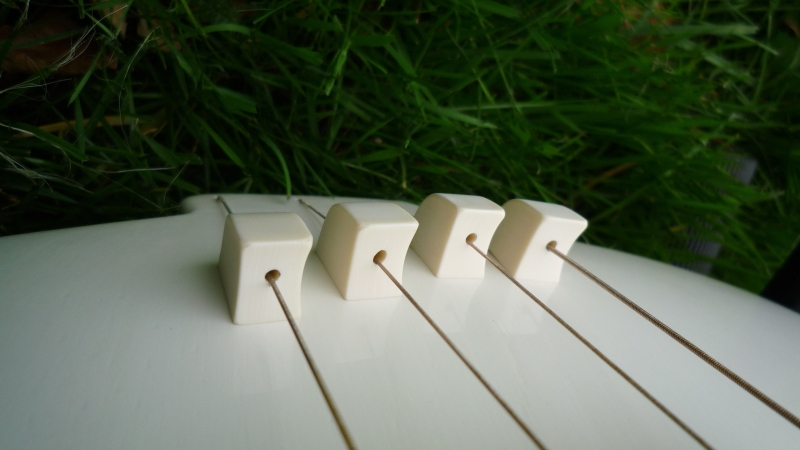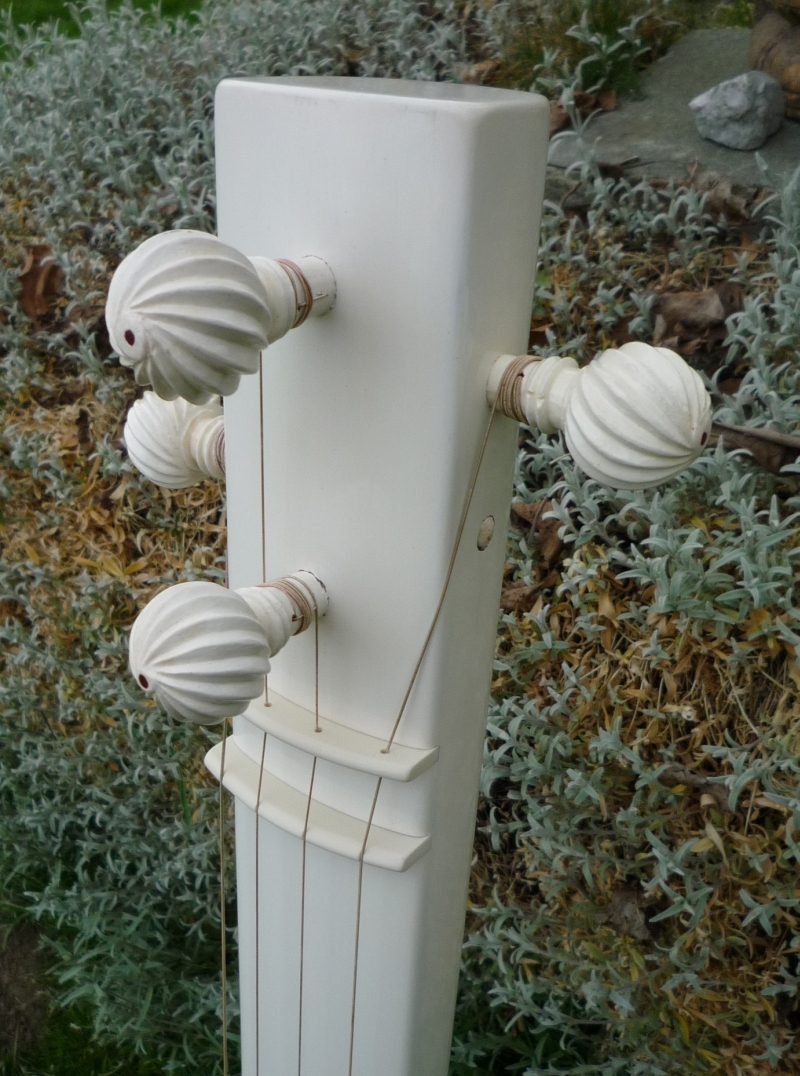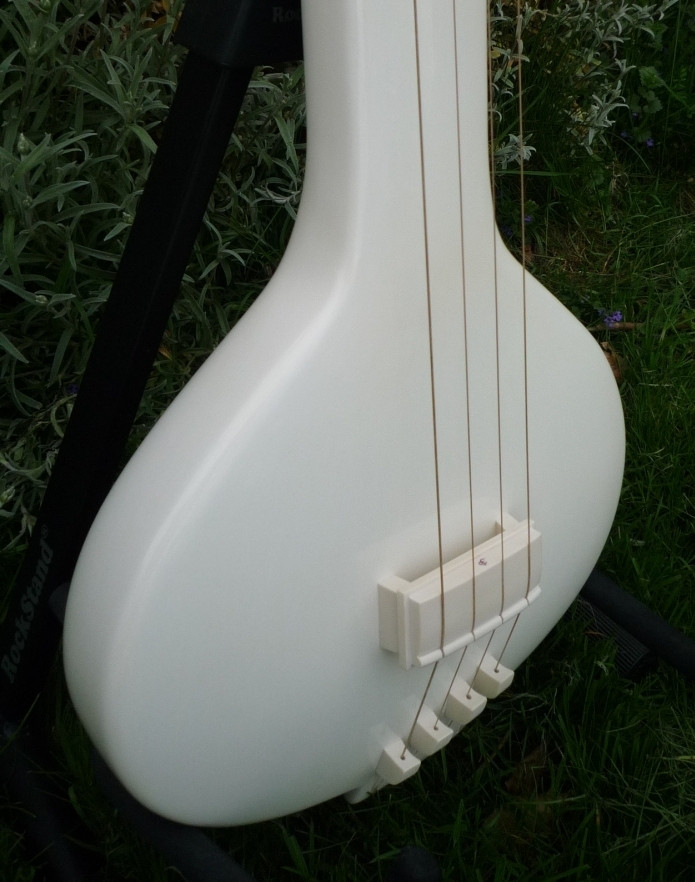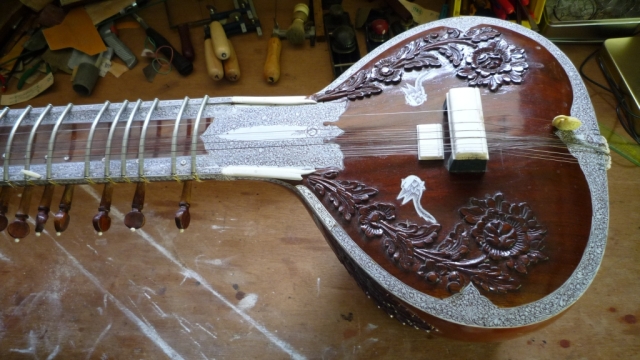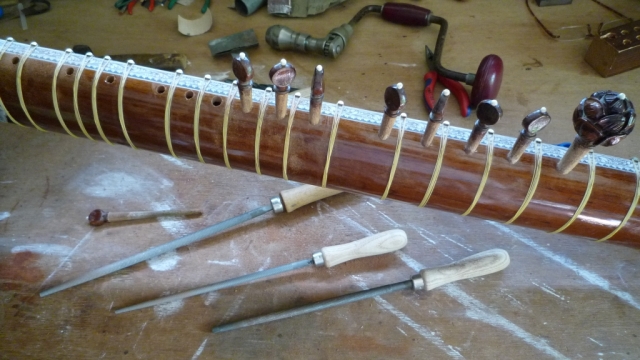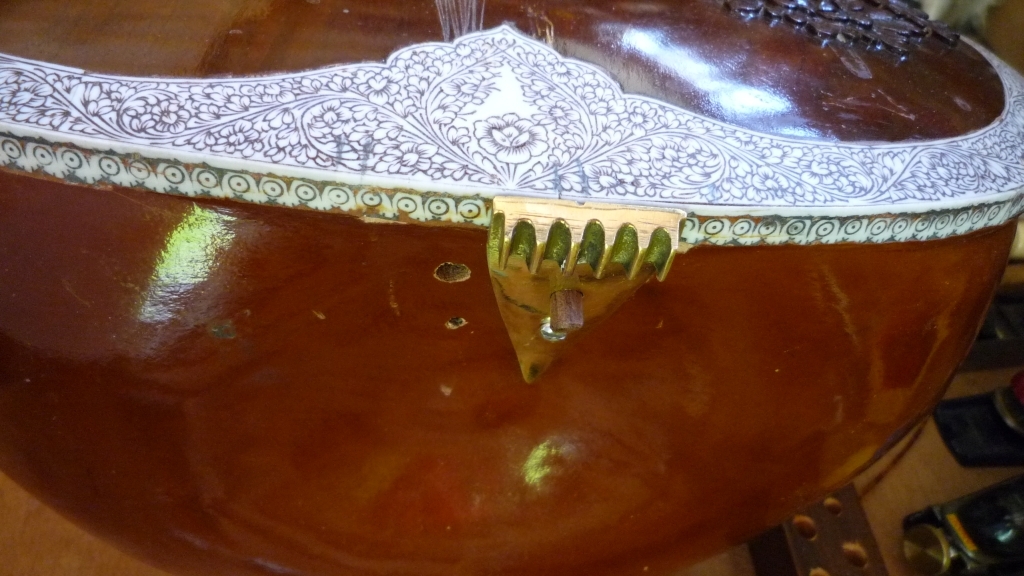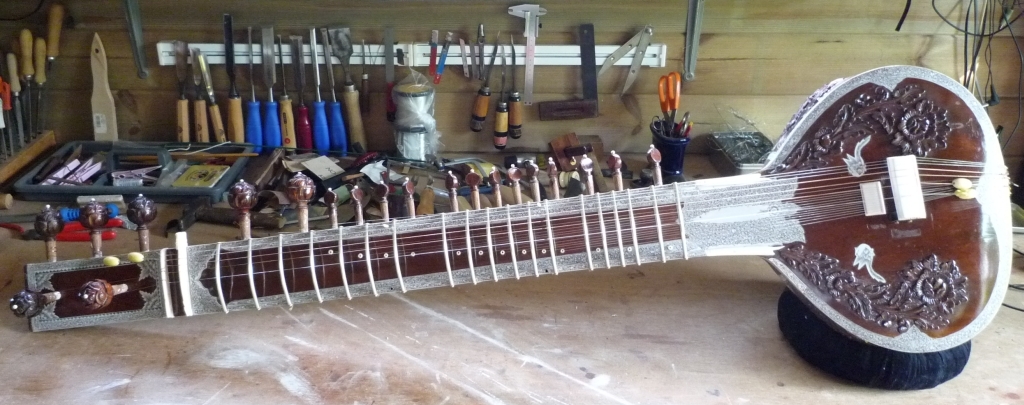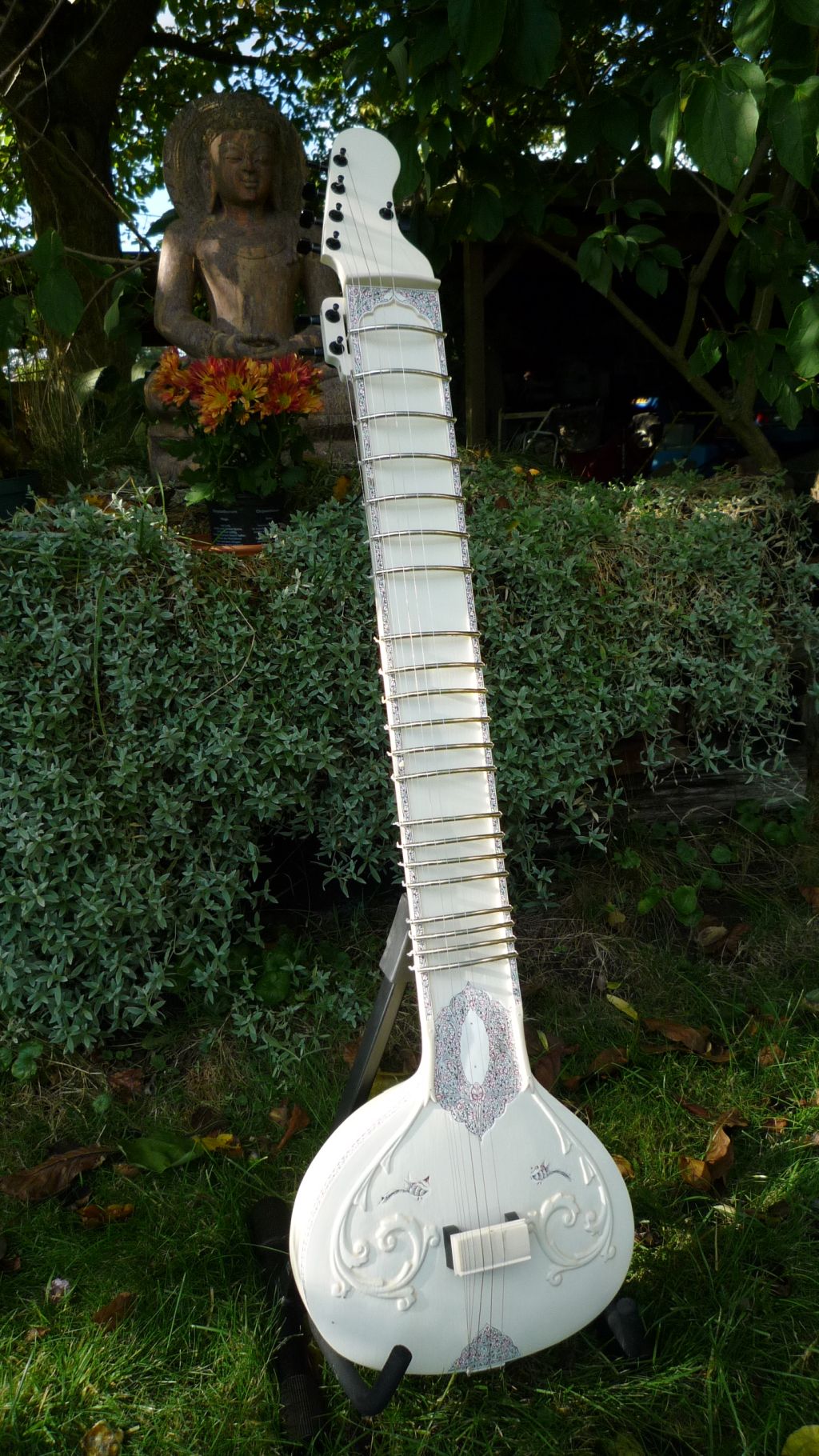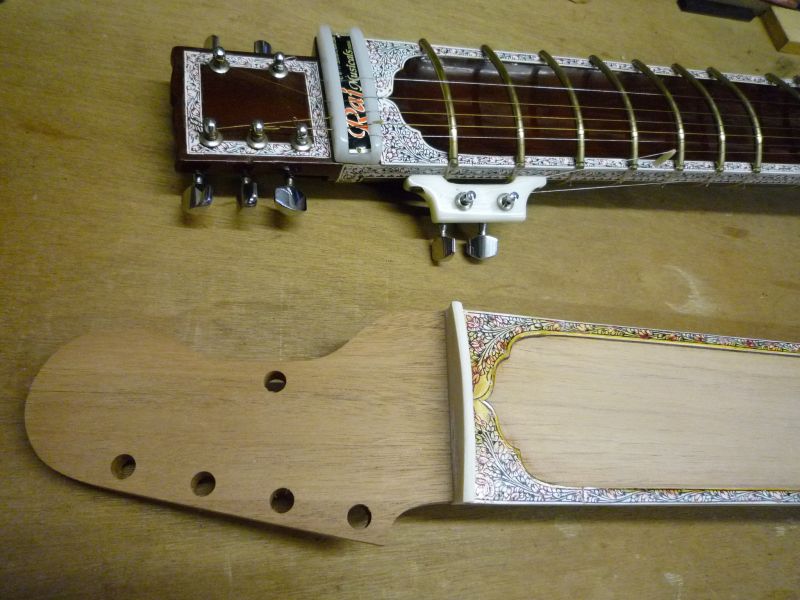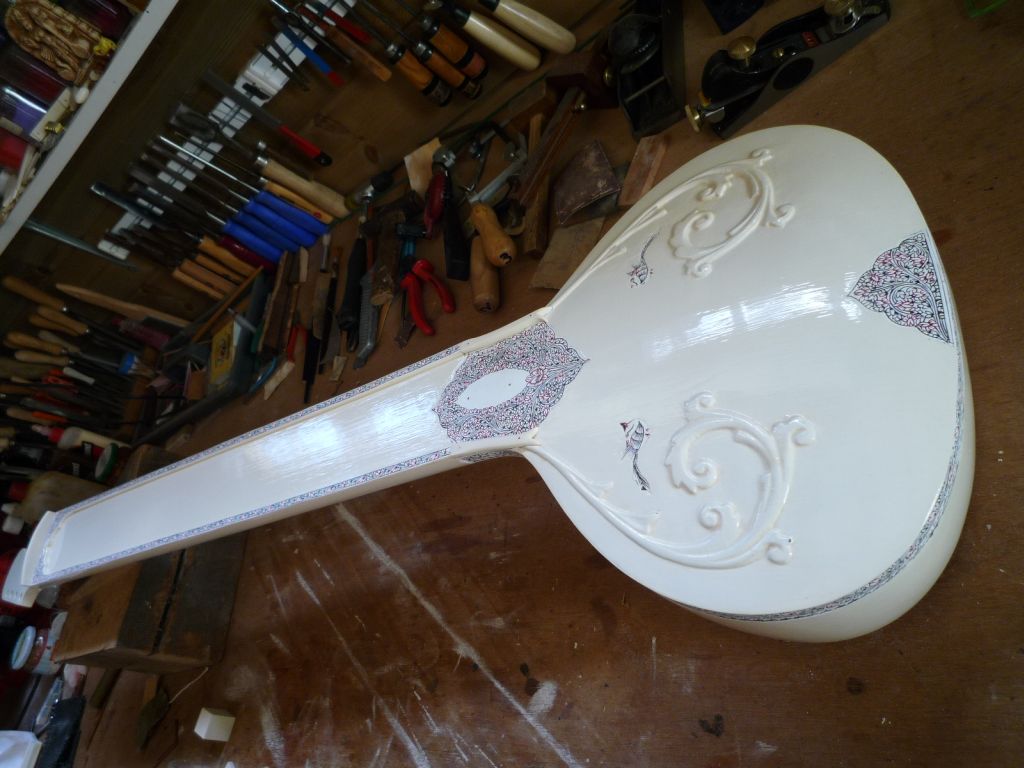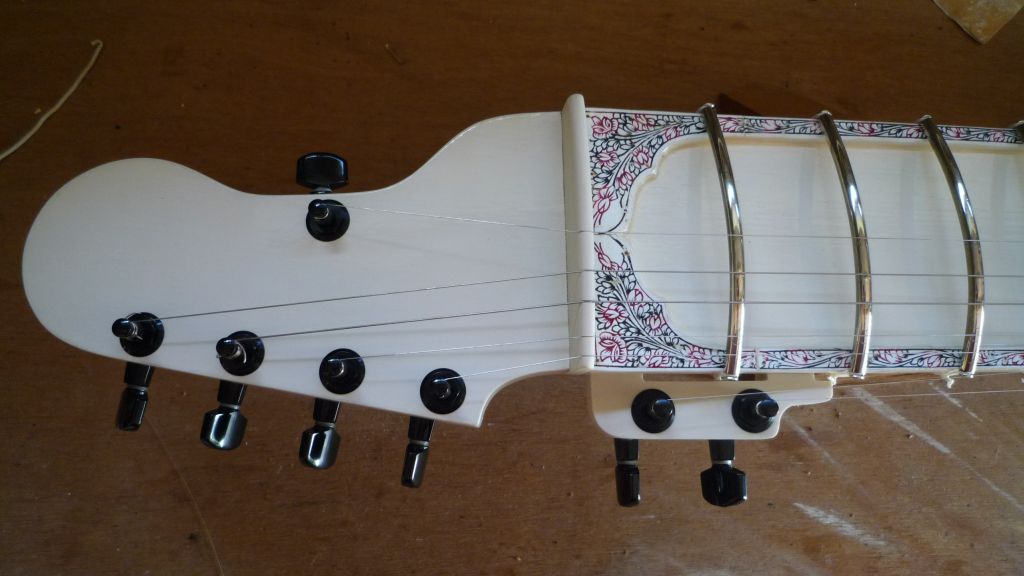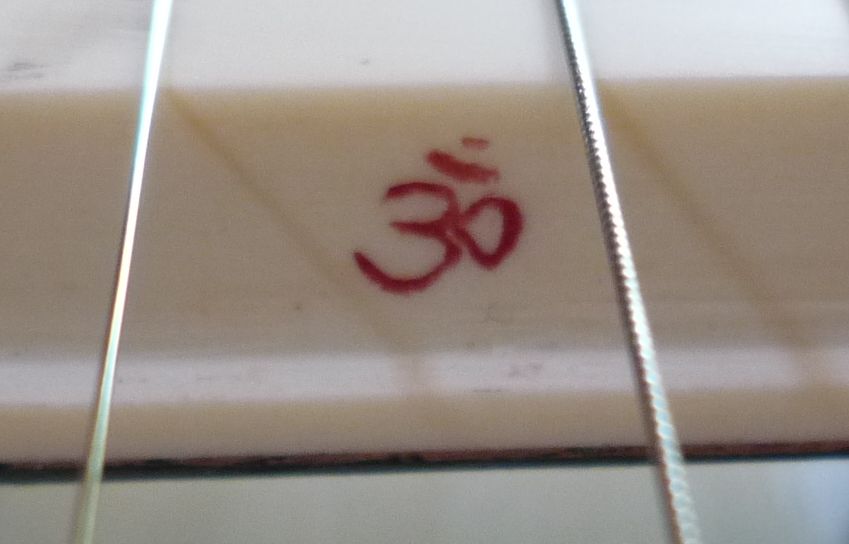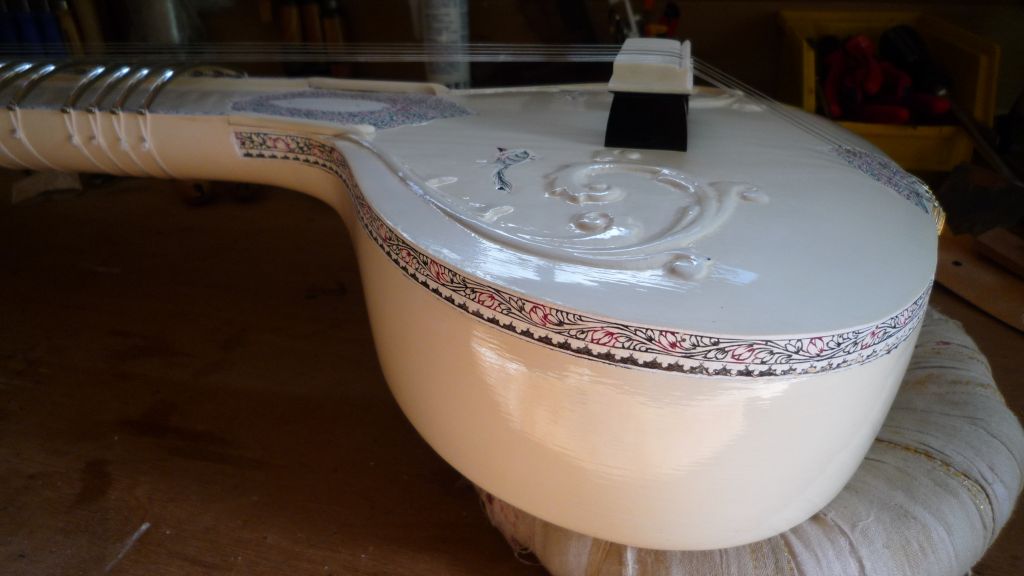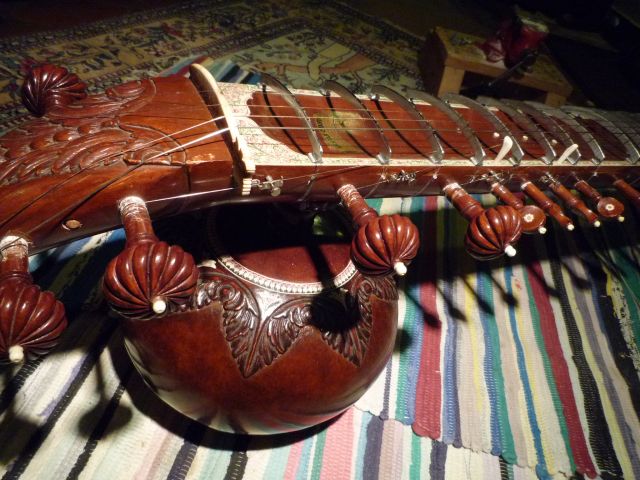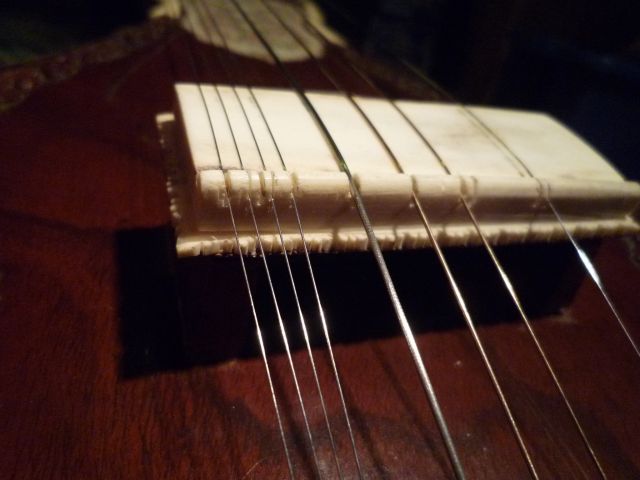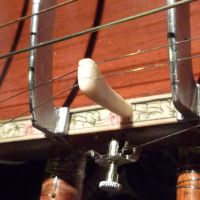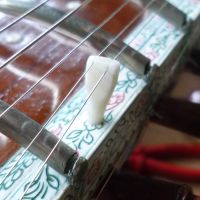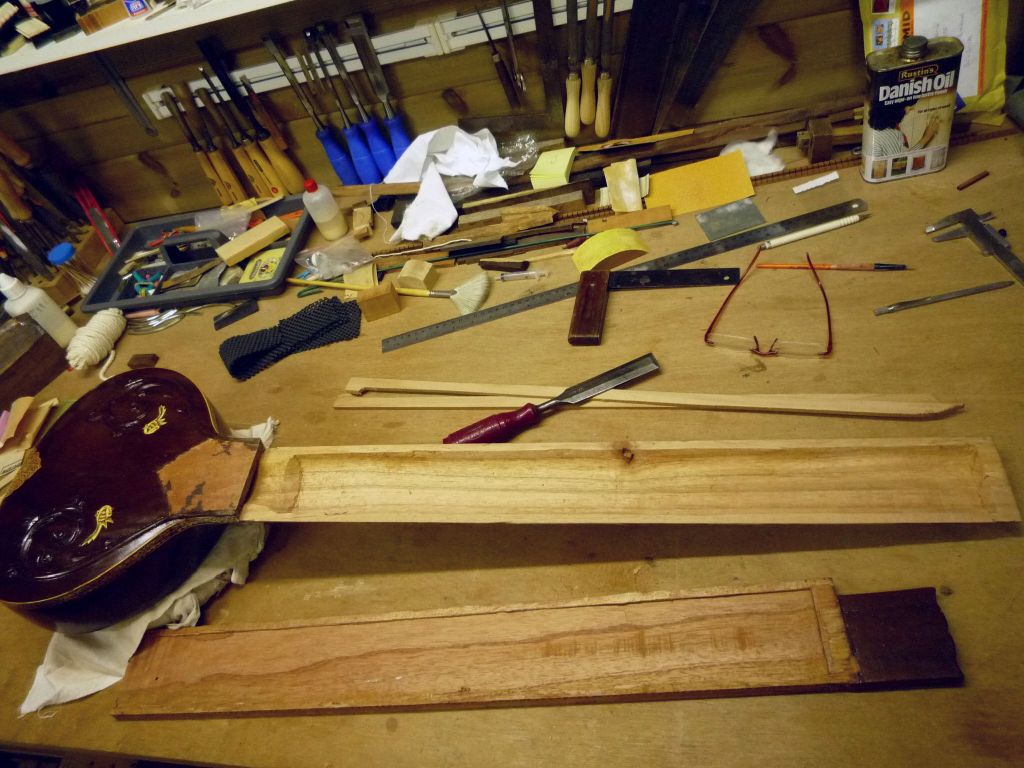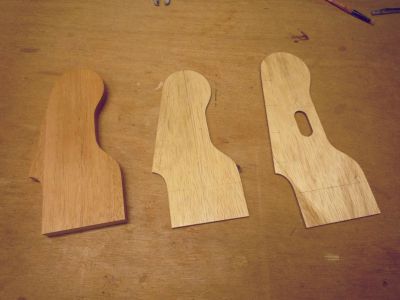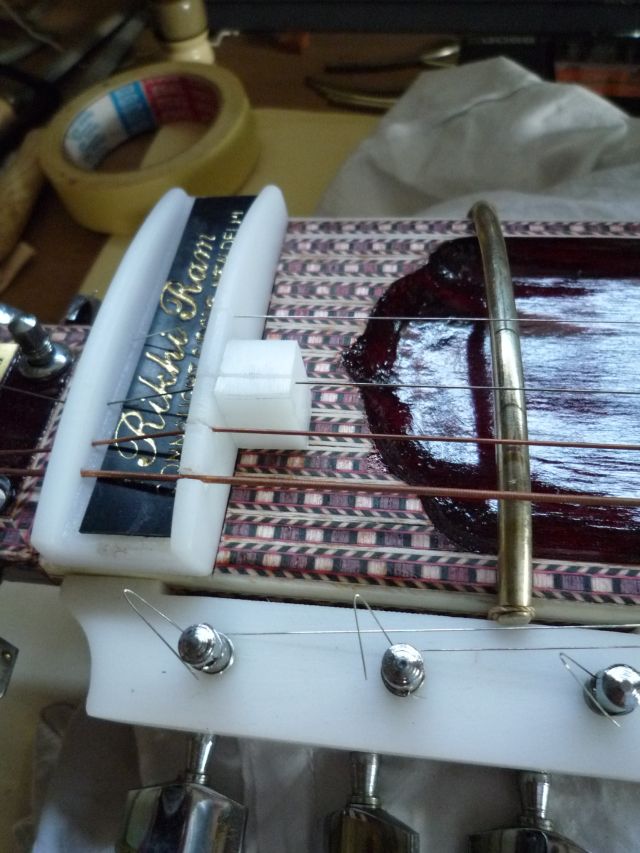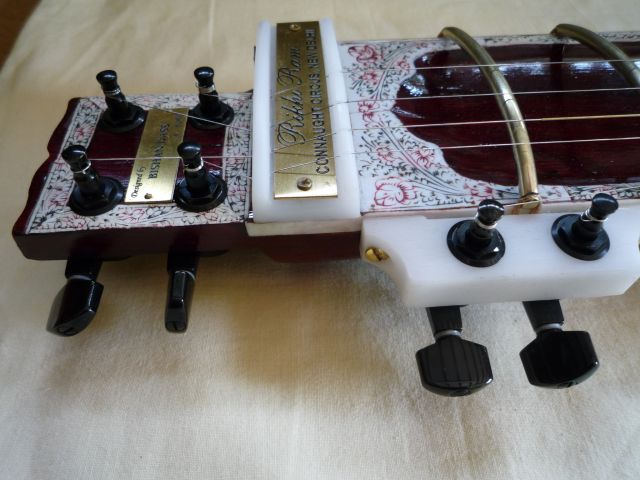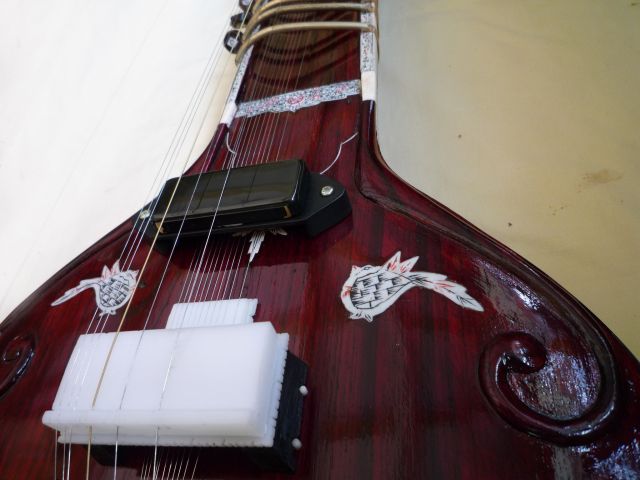Inspired by the white sitar mod i’ve painted this tanpurabody also in white using Bio Pin™ waterbased organic white paint and Colortone™ high gloss waterbased finish. The patri, jawari and mankas are all made from Elforyn™, a modern synthetic ivory substitute. So also this one became a real “organic & vegan” instrument,… 100% suitable for vegetarians… 🙂 … and she looks very neat too.
Tag Archives: SitarMods
Right to left hand modification
Modifying a sitar from right-hand play to left-hand play…
It is not easy to find a suitable sitar if you are left-handed and want to engage yourself into the world of sitar playing. There are good left-hand sitars for sale, but they are very rare and if you find one than there is still the price tag. So, why not modifying a regular sitar from right-hand play to left-hand play ?
Is it always possible ? Unfortunately the answer is no. Since the modern times sitars are more and more build a-symmetrically. In order to improve the meend-playability, the neck of a sitar is mounted slightly (… or more… and more) tilted. This is for our purpose the main downside…
Another one is that the kutis are to be changed from “upside” to “downside”. It will work, but on the new “downside” the holes will be too big. So, the kutis, and thus the tuning of the instrument might become some unstable. Practically, in many cases this will not become a very big issue. It is more of a theoretical matter but at some extreme cases…??
Next to the kutis comes the langoot (tail mount). This very important piece has to be shifted over the center to the right. No big deal at first, but before acting make sure that the wooden tailpiece which is mounted on the inside of the tumba is big enough to reach this new position because the peel of the gourd alone will never hold the high forces induced by all the strings on the langoot.
Last but not least the pardas are to be reversed too. Also here some luck is very welcome to prevent a lot of extra work. If the parda lanes are not nicely even and flat, one risks that on a certain moment the strings are starting to touch the adjacent parda. If this happens, then there is a big chance that you’ll have to reshape all of the following pardas… On this sitar, we decided not to reverse the pardas since they are pretty symmetrical from origine. Finally, the string position notches on the jawari are to be changed and the cikari pins symmetrically reversed. New strings are mounted.
The result looks a little strange because the jawari had to be shifted out of the tablis center, but this instrument is pretty good playable. So, very soon now the first lesson can be arranged…
Travel Sitar Mods (3B) … the white sitar
After finalizing the structural rough woodwork on the travel-sitar’s body (see Part 1 = Travel Sitar Mods (3A)) the final acts are: completing the body finish and preparing and installing the sitar’s hardware such as godi (jawari), machine heads, strings, pardas and eventually an electro-magnetic pickup.
I’ve painted the body in white using Bio Pin™ waterbased organic white paint and Colortone™ high gloss waterbased finish. The patri, jawari, cikari machine head mount and cikari posts are all made out of Elforyn™. So it became a real “organic & vegan” sitar,… 100% suitable for vegetarians… 🙂
Installing 7 Schaller™ Mini M6 machine heads and 20 bronze pardas N°6.
Main strings gauges :
1) Baj tar : steel, 0,30mm (N°3)
2) Jora tar : nickel flatwound, 0,46mm (N°26)
3) Laraj tar : nickel flatwound, 0,56mm (N°24)
4) Gandhar tar : steel, 0,30mm (N°3)
5) Pancham tar : steel, 0,30mm (N°3)
6) & 7) Cikari tar : steel, 0,23mm (N°0)
Some details :
Sitar Mods
Sitar Mod: adding 4th cikari, the alternative way…
Another young and dedicated Ashok Pathak sishya came to me with this old Hiren Roy sitar. The question came up again: Can you add an extra cikari string to this precious vintage sitar in order to meet the Balaram Pathak Garana style specifications? Since I am not so much in favour of starting to drill holes in old and valuable instruments, I decided to introduce an alternative way. Just as I did before with an old and beautiful Kartar Chand surbahar, I proposed to use the first tarav kuti to mount the 4th cikari string (high SA). This sitar came with 13 tarav strings. So then now 12 are left, which finally should be a good compromise…?
Since I am not so much in favour of starting to drill holes in old and valuable instruments, I decided to introduce an alternative way. Just as I did before with an old and beautiful Kartar Chand surbahar, I proposed to use the first tarav kuti to mount the 4th cikari string (high SA). This sitar came with 13 tarav strings. So then now 12 are left, which finally should be a good compromise…?
 Doing so, the workflow is highly reduced to the making and installing of a new cikari pin which can hold 2 cikari strings & re-organising the existing cikari string positions and adding an extra cikari string slide on the jiwari. Also the original last cikari string post (high SA) has to be replaced by a new pin.
Doing so, the workflow is highly reduced to the making and installing of a new cikari pin which can hold 2 cikari strings & re-organising the existing cikari string positions and adding an extra cikari string slide on the jiwari. Also the original last cikari string post (high SA) has to be replaced by a new pin.
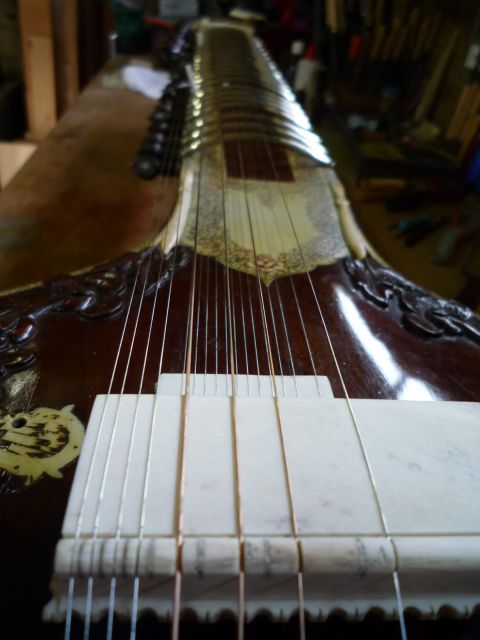 Also read: Sitar Mod: adding 4th cikari.
Also read: Sitar Mod: adding 4th cikari.
Surbahar Mod: adding 4th cikari
Adding an extra cikari string to this old Kartar Chand surbahar to meet the Balaram Pathak Garana style requirements.
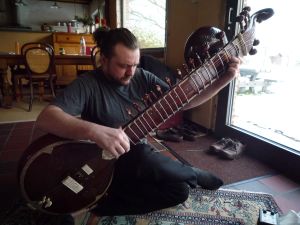
No new cikari kuti will be installed because of the surbahar neck construction. The imposant surbahar’s head is jointed to the neck. Therefore it is not obvious to drill an extra hole through this construction. But the solution is very simple: The first tarav kuti becomes the last cikari kuti. Since this kuti can hold every kind of string, there is no need for creating another new cikari kuti. I simply removed the first tarav string, drilled a hole in the outer kuti’s region and mounted the last cikari string to it. Optionally, later, i can always install an extra tarav kuti on the utter last position to regain the original tarav strings number.
On this instrument we have been re-directing the first (SA) cikari string under the patri. This results in an increased playing comfort concerning the Laraj Kharaj strings: no more incidental touching of the first cikari string while playing meend on the Laraj Kharaj strings.
This mod is then completed by adding an extra cikari slide on the jiwari, re-organising the cikari slide positions on the jiwari, adding an extra cikari pin and finally installing the strings itself.
The cikaris tuning is according to the raga specifications, but combinations like f.ex. Sa Dha Pa Pa do sound very nice.
Also on this surbahar, i mounted a new Kharaj string from German’s famous string maker Pyramid Strings. It is a nickel flatwound on steel .046w (1.22mm diameter). Superb string. Unheard long and deep sustain while playing meend, unrivalled tuning-stable, very soft and warm, deep bass sound. A real joy for player and listener…
Sitar Mod: adding 4th cikari
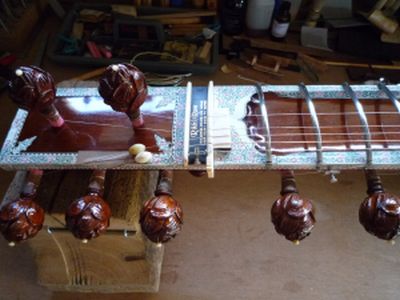
On a special demand from a young and dedicated Ashok Pathak sishya I’ve been adding an extra cikari string to his Rikhi Ram sitar in order to meet the Pathak Garana style specifications.
Here is the workflow: 1) Selecting and preparing a new kuti. 2) Marking and drilling the holes. 3) Fine tuning and fitting the new kuti. 4) Re-organising the existing cikari string positions and adding an extra cikari string slide on the jiwari.
5) Making and installing a new cikari pin which can hold 2 cikari strings. 6) Installing the string.
The general 4 cikari tuning is Pa Sa Sa Sa, but this can alter according to the raga you’ll play.
Travel Sitar Mods (3A)
Both Rikhi Ram brothers Ajay & Sanjay, and after them many others, make and sell this handy and compact sitar. Some call it “Ovation” sitar, some call it “Studio” sitar and also “Travel” sitar is commonly used for this successful innovative musical instrument. Commercially it is a succes. No doubt about that.
But here is a list of remarks and complaints with which players came to me after they have been buying a new travel sitar in New Delhi. In my opinion there are a number of improvements that could be achieved rather easily:
The pickup doesn’t sound good, and comes loose in no time. So you can install a better one. (see Travel Sitar Mods (1) )
The tuning machines are cheap and crappy, and can get stuck after a few string changes. Also here it’s a good investment to install better ones. (see Travel Sitar Mods (1) )
Not much care has been taken to fit the jora tar properly. Only one travel sitar from Sanjay’s Rikhi Ram was ok. Too often there is need for intonation adjustment. (see Travel Sitar Mods (2) )
There are also some complaints about the finishing touch:
Parda’s which were made too short are installed anyways. A friend of mine has lost a parda while performing on stage with his “brand new” instrument. Floops, suddenly there it goes…
The new style decoration strips look like a cheap copy of simple western repetitive patterns. And when they are fit on the body they are not always correctly matching.
And finally there is my personal opinion concerning the “amputated” head. Of course this square leftover stump is one of the main basic improvements made to recent sitar making and playing in general since many years. But to me, it doesn’t look beautiful. I regret the lack of creativity. Isn’t it a missed chance to make this sitar look nicer on stage?
So, inspired by my own developed series of new style sitars I want to introduce my ultimate travel sitar modification. For this experiment I use a travel sitar body which I’ve been buying from Raj Musicals in New Delhi.
I started with opening the sitar neck and removing the square stump piece. Then I created a new head piece derived from the SAS and SBS sitar heads draft. In order to maintain strenght in the new construction the original neck’s top plate also had to be renewed. The celluloid decoration will be re-used on top of the new plate.
Travel Sitar Mods (2)
This modification I made to Mark B’s Travel sitar because he was unable to play the jora tar comfortably. The steel wire jora tar, although open correctly tuned, sounded too high while playing a note on the pardas.
I added a fibre intonation block to the jora tar, just as I did with my own made SAS and SBS sitars. Now he can play the jora tar up to the middle note Sa without any problem and accurately without meend.
Travel Sitar Mods (1)
I ‘ve made some simple and interesting technical modifications to Frederic T’s new travel sitar. He has bought it last year in New Delhi.
1) I have installed Schaller™ M6 mini machine heads. These run so much more smooth and accurate then the rather cheap and crappy original machines.
2) Also mounted a Kent Armstrong Slimbucker™ Jazz guitar pickup which brings it very close to the sound of a full scale Jazz Sitar.



